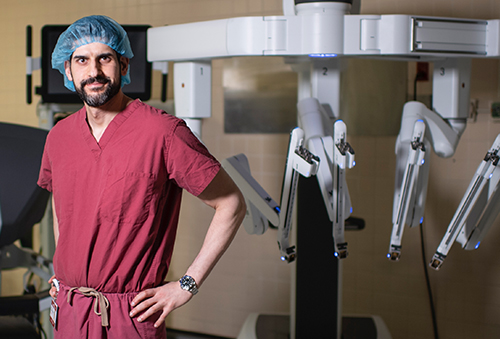“This is a very exciting time in robotics for pediatric urology,” says Ardavan Akhavan, MD, Director of Pediatric Robotic Surgery in the Institute of Pediatric Urology at NewYork-Presbyterian Komansky Children’s Hospital and Weill Cornell Medicine. “We have created one of the few dedicated, comprehensive pediatric robotics surgery programs in the region, offering the robotic option for almost any child and infant requiring abdominal urological surgery. Our program is unique in that we are able to successfully operate on children as young as two months of age. In many cases, we begin working with families before their baby is born, when urologic issues are identified on prenatal ultrasounds.”

Dr. Ardavan Akhavan
Dr. Akhavan has been performing pediatric robotic surgery for nearly a decade. He is highly specialized in managing disorders associated with the upper and lower urinary tract, including obstruction and vesicoureteral reflux, with minimally invasive techniques. He also has expertise in complex robotic reconstruction, including robotic Mitrofanoff appendicovesicostomy and bladder neck reconstruction for children with incontinence secondary to neurogenic bladder from spinal cord injury or spina bifida.
With robotic surgery, Dr. Akhavan strives to optimize patient outcomes while minimizing discomfort, length of hospitalization, and time to return to normal activities. “In many cases, the difference in recovery when compared to open surgery is striking,” he says. “Reduced analgesic use and faster recovery are among the major benefits of minimally invasive robotic surgery; furthermore, many children don’t need narcotics after surgery. When a child is recovering from surgery, the entire household is affected. The child can’t go to school; the parent(s) take time off from work; the whole family’s life is put on hold. With robotic surgery, the majority of patients are back to most of their normal activities in one or two days, so this can have a profound effect on the family’s experience.”
“Improved cosmesis is also a major consideration,” continues Dr. Akhavan. “While larger incisions can stretch as the child grows, 8mm robotic port incisions tend to shrink over time.”
Our robotics program here at NewYork-Presbyterian Komansky Children’s Hospital is unique in that we are able to successfully operate on children as young as two months of age.
— Dr. Ardavan Akhavan
Dr. Akhavan routinely participates in multi-institutional collaborations with other high-volume programs to further advance the role of robotics in pediatric urologic surgery and improve patient care. “We’re pooling all of our data to validate outcomes, standardize treatment approaches, and promote the adoption of the technology,” he says.
In one such study, Dr. Akhavan and colleagues from around the country assessed the safety and efficacy of robot-assisted laparoscopic extravesical ureteral reimplantation (RALUR-EV) in children among experienced surgeons. The prospective analysis evaluated success rate, surgical technique, and complications among surgeons who have overcome the initial learning curve. Their findings, published in the June 2018 issue of the Journal of Pediatric Urology, showed that of the 143 patients included in the study, radiographic resolution of vesico-ureteral reflux following RALUR was almost identical to the resolution rate associated with open procedures and had a similarly low incidence of complications. The researchers demonstrated that robot-assisted laparoscopic extravesical ureteral reimplantation is a safe and viable option for management of VUR in children.
“In terms of size and the age of patients who are eligible for surgery, there’s very little that we haven’t been able to accomplish robotically thus far,” says Dr. Akhavan. “Our goals are to continue to improve outcomes, reduce hospitalization stays, and decrease pain and complications.”



